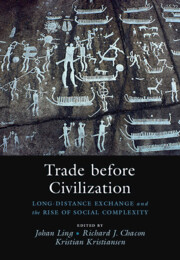Book contents
- Trade before Civilization
- Trade before Civilization
- Copyright page
- Contents
- Contributors
- Chapter One New Perspectives on Long-Distance Trade and Social Complexity
- Part I Exchange and Social Evolution: Forms of Trade in Egalitarian, Transegalitarian, and Chiefdom Societies
- Part II The Role That Specific Institutions And Agents Played in Long-Distance Exchange
- Part III The Role of Political Economy and Elite Control in Long-Distance Exchange
- Part IV Marxian And Post-Colonial Approaches as well as World System Theory in Relation to Gift Exchange and MacroRegional Exchange
- Chapter Twelve Value and the Articulation of Modes of Re-Production
- Chapter Thirteen Entrepreneurs, Metals and Change
- Chapter Fourteen Long-Distance Interaction in Fourth Millennium bce Eurasia
- Chapter Fifteen Following the Bread Crumbs
- Part V Commentary on Contributions to This Volume
- Index
- References
Chapter Fifteen - Following the Bread Crumbs
Epistemological and Methodological Issues in the Interpretations of Long-Distance Trade in the Caribbean
from Part IV - Marxian And Post-Colonial Approaches as well as World System Theory in Relation to Gift Exchange and MacroRegional Exchange
Published online by Cambridge University Press: 25 August 2022
- Trade before Civilization
- Trade before Civilization
- Copyright page
- Contents
- Contributors
- Chapter One New Perspectives on Long-Distance Trade and Social Complexity
- Part I Exchange and Social Evolution: Forms of Trade in Egalitarian, Transegalitarian, and Chiefdom Societies
- Part II The Role That Specific Institutions And Agents Played in Long-Distance Exchange
- Part III The Role of Political Economy and Elite Control in Long-Distance Exchange
- Part IV Marxian And Post-Colonial Approaches as well as World System Theory in Relation to Gift Exchange and MacroRegional Exchange
- Chapter Twelve Value and the Articulation of Modes of Re-Production
- Chapter Thirteen Entrepreneurs, Metals and Change
- Chapter Fourteen Long-Distance Interaction in Fourth Millennium bce Eurasia
- Chapter Fifteen Following the Bread Crumbs
- Part V Commentary on Contributions to This Volume
- Index
- References
Summary
At the arrival of Columbus to the Americas, the Spanish concentrated their colonial enterprise in the Caribbean. Here they encountered some groups that showed strong social differentiation but without the presence of a state bureaucracy. It is for this reason that the ancient Caribbean has been considered since early on by anthropology and archaeology as an ideal place for the study of non-state, stratified societies (e.g., Fewkes 1907; Mason 1941). For example, recognizing the stratification among these groups and, yet, the absence of the institution of the state, Steward (1948) classified them as the Circum-Caribbean Tribes, eventually becoming an intermediate stage in his evolutionary scale between the egalitarian and traditional Tropical Forest Tribes and the Andean civilizations. The description of this category is very similar to today’s concept of chiefdom developed decades later by Service (1962), a former student of Steward. In 1955, Oberg also used the Caribbean as an example of a category in his classification system that he called Political Organized Chiefdoms, the first time the term chiefdom was formally defined in anthropology. The interest on the Caribbean waned in anthropological archaeology in the 1960s with the advent of the New Archaeology that favored focusing on the study of stratified societies on the so-called core areas such as Mesoamerica and the Andes.
- Type
- Chapter
- Information
- Trade before CivilizationLong Distance Exchange and the Rise of Social Complexity, pp. 361 - 382Publisher: Cambridge University PressPrint publication year: 2022

